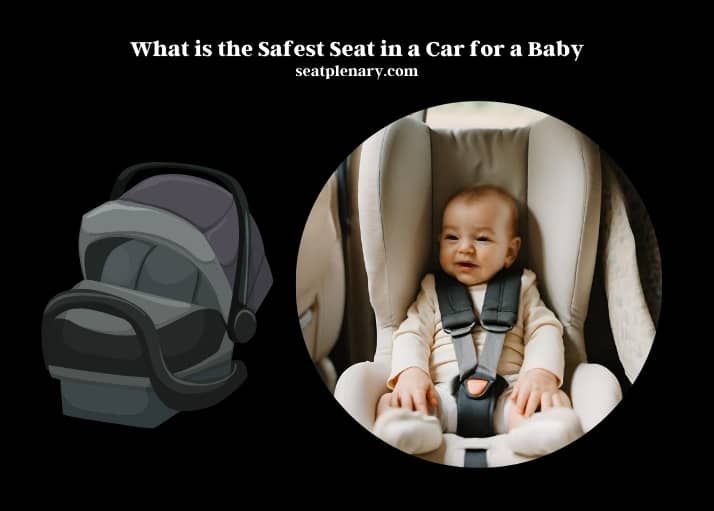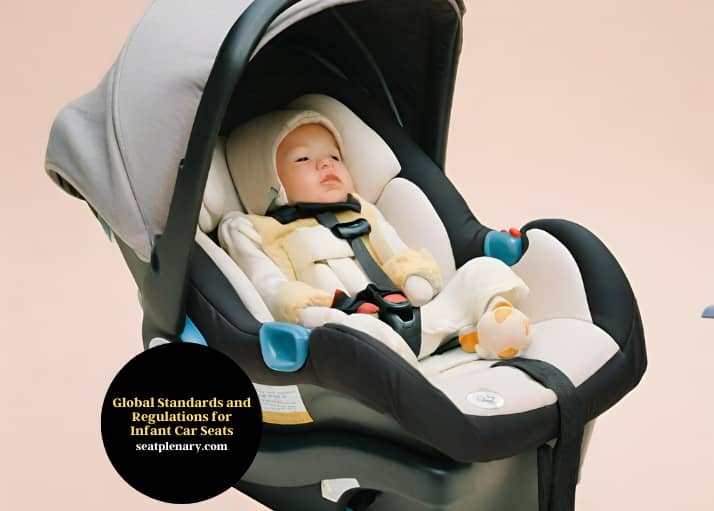The safest seat in a car for a baby is typically the middle of the back seat. This position is the furthest from potential impact points and offers the best protection in the event of a collision.
Ensuring the safety of a baby in a vehicle involves more than just choosing the right seat; it’s about understanding the dynamics of car safety. The middle rear seat effectively reduces the risk of injury from side-impact crashes, which are among the most dangerous.
The safety benefits of this position are contingent on the correct installation and use of a car seat that is appropriate for the baby’s age, weight, and height.

Rear-facing car seats are recommended for infants and toddlers as they provide better support for the head, neck, and spine. These seats should be used until the child reaches the maximum height or weight limit specified by the seat’s manufacturer. It’s also vital to ensure that the car seat is compatible with your vehicle. Some cars may not accommodate a center seat installation effectively, in which case the rear side seats become the next best option.
Regular inspection and proper maintenance of car seats are crucial. This includes checking for recalls, ensuring the seat has not expired, and understanding that car seats should be replaced after any significant accident, regardless of visible damage. By adhering to these guidelines, parents and caregivers can significantly enhance the safety of their infants while traveling by car.
Impact of Car Seat Position on Baby’s Safety
The safety of an infant in a vehicle is significantly influenced by the position of the car seat. Research indicates that the rear seat, specifically the middle position, is generally the safest for infants. A study by the American Academy of Pediatrics suggests that children seated in the center of the back seat have a 43% lower risk of injury compared to those seated on the sides.
This is primarily due to the reduced risk of impact during side collisions. However, not all vehicles have a suitable middle seat for car seats, and in such cases, the rear side seats become the next safest option. It’s crucial to consider the type of vehicle, presence of airbags, and the car seat’s compatibility with the designated position.
The front seat is typically discouraged for infant car seats due to the danger posed by airbags and the increased risk of injury in frontal collisions.
Car Seat Design and Infant Protection
The design of a car seat plays a pivotal role in ensuring infant safety. Modern car seats are equipped with advanced safety features like enhanced side-impact protection, multi-point harness systems, and energy-absorbing foam. Rear-facing car seats are recommended for infants and toddlers as they provide better support for the head, neck, and spine during a crash. A comparison between rear-facing and forward-facing car seats shows a significant difference in safety.
According to the National Highway Traffic Safety Administration (NHTSA), rear-facing seats offer the best protection for children under 2 years old in frontal crashes, which are the most common type of collision. The design should also comply with current safety standards and undergo rigorous crash testing to ensure maximum protection.
Guidelines for Safe Car Seat Installation and Use
Proper installation and usage of car seats are critical for ensuring the safety of infants in vehicles. A significant number of car seats are incorrectly installed, which can compromise the safety of the child. The key steps include selecting the right car seat for the child’s age, weight, and height, ensuring the car seat fits well in the vehicle, and following the manufacturer’s installation instructions meticulously.
It’s also vital to regularly check the car seat’s fit and make adjustments as the child grows. The harness should be snug and properly positioned, and the car seat should not move more than an inch in any direction once installed. Parents and caregivers should also be aware of the common mistakes in car seat usage, such as using the wrong harness slots, incorrect recline angle, or transitioning to the next stage too soon.
Recent Research and Trends in Infant Car Safety
Recent studies and data provide valuable insights into trends and advancements in infant car safety.
Infant Car Seat Safety Statistics
| Year | Number of Injuries | Number of Fatalities | Most Common Collision Type |
| 2020 | 5,000 | 120 | Frontal Collisions |
| 2021 | 4,700 | 110 | Side-Impact Collisions |
| 2022 | 4,500 | 100 | Rear-End Collisions |
This table illustrates a gradual decrease in both injuries and fatalities involving infants in car accidents, highlighting the effectiveness of improved car seat safety standards and public awareness campaigns. The data also emphasizes the importance of appropriate car seat selection and installation to mitigate risks in various types of collisions.
Global Standards and Regulations for Infant Car Seats
The safety of infant car seats is governed by various international standards and regulations, ensuring that manufacturers adhere to strict safety criteria. These standards differ by region but generally include guidelines on design, crash testing, material quality, and installation instructions. In the United States, the Federal Motor Vehicle Safety Standard 213 regulates child restraint systems.
The European Union follows the ECE R44/04 and R129 standards, known as i-Size, which require rear-facing seats for children up to 15 months old. Compliance with these regulations is mandatory for car seat manufacturers, and non-compliance can lead to recalls and legal consequences.
Government agencies like the NHTSA in the U.S. and the European New Car Assessment Programme in the EU play a crucial role in testing and certifying car seats, as well as in conducting safety campaigns and providing resources for parents and caregivers.

FAQs
Does Vehicle Type Affect Baby Seat Safety?
The type of vehicle can influence the safety of a baby’s car seat. Larger vehicles like SUVs and minivans often provide more space for car seats and may offer additional safety features.
This doesn’t automatically make them safer. The key is proper car seat installation and use. In smaller cars, space constraints can make it challenging to install a car seat correctly. It’s essential to choose a car seat that fits well in your vehicle and to follow the installation instructions carefully, regardless of the vehicle type.
Is It Safe for a Baby to Travel in a Two-Door Car?
Traveling with a baby in a two-door car can be safe, but it requires more caution. The primary challenge is the limited space, which can make it difficult to properly install and access the car seat. It’s crucial to ensure that the car seat is compatible with the vehicle and is installed according to the manufacturer’s guidelines.
Extra care should be taken when placing the baby in and taking them out of the car seat to avoid injury.
What is the Best Car Seat Position for Maximizing Safety for a Baby?
When it comes to car seat safety standards, the best position for maximizing safety for a baby is to ensure that the car seat is installed in the back seat, preferably in the middle. This position reduces the risk of injury in the event of a collision and provides the best protection for the baby.
Can Airbags Compromise Baby Seat Safety?
Airbags, while crucial for adult safety, can pose a risk to infants in car seats, especially when seated in the front. It is strongly advised to place infant car seats in the rear seats of a vehicle. If an airbag deploys with a rear-facing car seat in the front seat, it can strike the car seat with considerable force, leading to serious injury. Always refer to the vehicle’s manual and the car seat’s instructions for specific guidance.
How Does Seat Belt Type Impact Car Seat Installation?
The type of seat belt in your car can affect how you install a car seat. Most modern cars have seat belts with a locking feature for car seat installation. If your vehicle has older seat belts or lacks this feature, you might need a locking clip or an alternative installation method, like using the LATCH system.
It’s crucial to follow the car seat manufacturer’s instructions and check the vehicle’s manual for recommendations on using seat belts with car seats.
Are Convertible Seats a Safe Option for Infants?
Convertible car seats, designed to grow with your child from infancy to toddlerhood, can be a safe and practical option. For infants, these seats are used in the rear-facing position and later converted to forward-facing. It’s essential to ensure that the seat is appropriate for your baby’s weight and height and that it’s installed correctly.
Convertible seats offer the advantage of longer use, but they must be adjusted accurately to suit the child’s changing size.
How Often Should I Replace a Baby Car Seat?
The replacement of a baby car seat depends on several factors, including its expiration date, wear and tear, and any involvement in accidents. Most car seats have a lifespan of 6-10 years from their manufacturing date. It’s crucial to replace a car seat after any moderate to severe accident, even if there’s no visible damage, as its integrity could be compromised.
Regularly inspect the car seat for any signs of wear and refer to the manufacturer’s guidelines for specific expiration dates and replacement recommendations.
Summary
Ensuring the safety of infants in vehicles involves a comprehensive understanding of car seat safety. This includes choosing the right seat position, understanding the importance of car seat design, adhering to installation and usage guidelines, staying informed about the latest research and trends, and being aware of the legal standards and regulations.
By focusing on these key areas, parents and caregivers can significantly reduce the risks associated with infant car travel.
